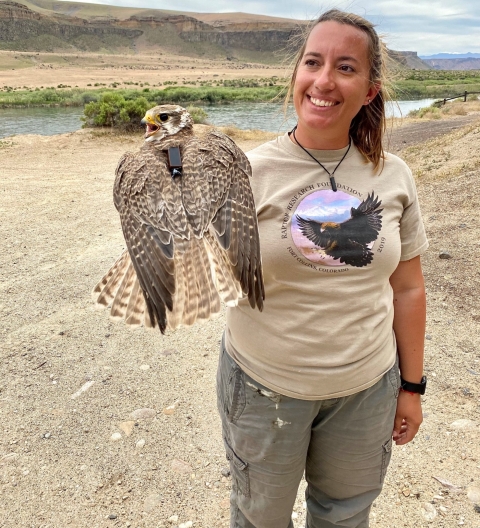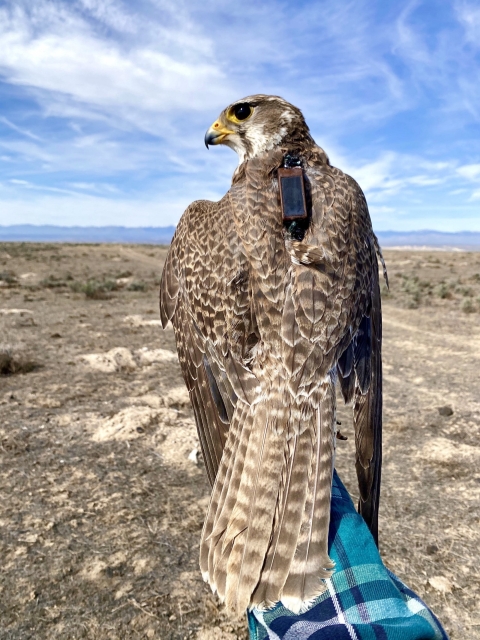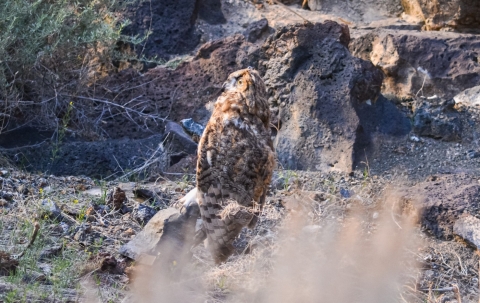You fly fast and hunt prey. You play and perform stunts in the air, nest on sheer rock faces, and dominate the skies above arid, treeless landscapes. You defend your vulnerable falcon chicks with intense ferociousness. You’re one of the coolest birds in the desert and you know it.
Now — stay with me — imagine that there’s a great horned owl threatening your nest. Your blood boils and you go straight into beast mode. You dive for the owl, wings tucked, ready to scare the potential chick-burglar out of your territory. You’re close, you’re ready…
And you fly straight into a net.
You’re outraged and embarrassed — how could you have fallen for that dumb net trick? — but after your feathers settle a bit, you realize you’ve been duped for a good cause. The biologists who snagged you just wants to learn more about you. And why not? You’re totally fascinating, right? You can even forgive them for using a robot taxidermy owl instead of a real one. Those robot-things are actually pretty sweet, you think to yourself.
Boise State University master’s degree student Eden Ravecca thinks they’re pretty sweet, too.
“We use a remote control to move the head and wings,” Ravecca said. “We stay in camo and use a camouflage blanket. We put up these mist nets, which are these really fine nets that can capture the birds. They’re almost invisible. If the falcons try to engage with the owl, they’ll come in contact with the mist net.”
Raptor Research: Prairie Falcons and Habitat Change
Ravecca conducts research for Boise State University’s Raptor Research Center, a one-of-a-kind program that supports student work on raptors and their habitats. Ravecca’s research is supported by the Raptor Research Center and the Department of Biological Sciences at Boise State University, the U.S. Fish and Wildlife Service (Service), Idaho EPSCoR, the Idaho Army National Guard, and the U.S. Geological Survey. She’s gathering data on the foraging movements of prairie falcons in the Morley Nelson Snake River Birds of Prey National Conservation Area (NCA), a stunning landscape in Snake River Canyon that’s home to the greatest concentration of nesting birds of prey in North America and managed by the Bureau of Land Management.
Matt Stuber, the Service’s Pacific Region eagle coordinator, is working closely with Ravecca on data gathering.
“Eden’s research really supports the mission of the Fish and Wildlife Service,” Stuber said. “We’ll be able to use her results in our own conservation efforts. The Snake River Canyon is important prairie falcon habitat, and we are excited to learn if and how landscape changes have impacted their behavior. We’ll be able to use what Eden learns in the NCA and apply it to other areas where landscape changes are on the horizon or are already occurring.”
Snake River Canyon is characterized by a sagebrush sagebrush
The western United States’ sagebrush country encompasses over 175 million acres of public and private lands. The sagebrush landscape provides many benefits to our rural economies and communities, and it serves as crucial habitat for a diversity of wildlife, including the iconic greater sage-grouse and over 350 other species.
Learn more about sagebrush steppe ecosystem. Miles of native grasses, sagebrush, and shrublands provide habitat for animals such as sage-grouse, mule deer, golden eagles, and black-tailed jackrabbits. However, this iconic landscape has changed significantly in the last 50 years, negatively affecting the ability of these plants and animals to thrive.
Altered fire regimes, land use disturbances, and the invasion of non-native grasses have degraded habitat. These transformations have also been influenced by climate change climate change
Climate change includes both global warming driven by human-induced emissions of greenhouse gases and the resulting large-scale shifts in weather patterns. Though there have been previous periods of climatic change, since the mid-20th century humans have had an unprecedented impact on Earth's climate system and caused change on a global scale.
Learn more about climate change . Increasing temperatures have led to decreased snowfall and alterations in precipitation patterns, higher water temperatures and lower river flows, and the drying out of sagebrush steppe habitat. A drier habitat has fueled bigger and more devastating wildfires, which have in turn led to a more rapid proliferation of invasive species invasive species
An invasive species is any plant or animal that has spread or been introduced into a new area where they are, or could, cause harm to the environment, economy, or human, animal, or plant health. Their unwelcome presence can destroy ecosystems and cost millions of dollars.
Learn more about invasive species .
“There were a lot of big fires since the 1980s,” Ravecca said. “There’s been a big reduction in the amount of shrub habitat. The Piute ground squirrel is the main source of prey for predators and raptors in the area, and the squirrels tend to prefer native grasses and shrub habitat. I’m looking at these top predators and studying how the habitat disturbances affect prairie falcons and their foraging behavior.”
Ravecca is looking at the broader picture of habitat change — influenced by the impact of all these environmental shifts — and how it is affecting the foraging behavior of prairie falcons. Are foraging areas selected by individual prairie falcons based on habitat, prey availability, or both? If habitat changes are affecting the location and abundance of the Piute ground squirrel, what does that mean for hungry prairie falcons?
One of the key data-gathering tools for understanding the movement of the raptors in the NCA are GPS transmitters. These little solar-powered backpacks sit between the shoulders on a falcon’s back and send Ravecca flight information. The data comes in three days a week and registers the birds’ locations at two second intervals during flight. There are currently ten transmitters out on breeding adult prairie falcons in the NCA. Ravecca has already captured and telemetered two in the last few weeks and plans to equip more birds this spring.
But how do the transmitters get onto the backs of the falcons? Enter: Maynard, the taxidermy robotic great horned owl.
Maynard: Bot, Beast, and Bait
Maynard is a robot. He can still move, but only via remote control. His head can turn side to side, his wings can move up and down, and he still has the capacity to scare unsuspecting raptors. Like other mechanical falcons, Maynard was once alive. According to Stuber, most of the lure owls were hit by cars and either killed on impact or subsequently euthanized.
When Ravecca and her team planted Maynard in prairie falcon territory, the raptors did what raptors do: they tried to protect their young.
“Prairie falcons are really territorial,” Ravecca said. “The great horned owl is their primary predator. They see the owls as a threat to their young. Their instinct is to attack.”
Ravecca and her team used Maynard in 2021 as the primary lure to capture falcons in the NCA. While Maynard has been effective in luring falcons, Ravecca still needed to contend with another barrier: the prairie falcon’s wicked intelligence.
There were a few falcons, Ravecca shared, who seemed to delight in mocking the biologists and their attempts at capture. After escaping the net three or four times, one falcon sat a few feet above the net and then knocked it down. Another falcon used its feet to punch the head off the owl. The head flew off and rolled down the hill. Ravecca never found it again.
“Most of the birds are very aware of their surroundings,” Ravecca said. “These birds don’t make mistakes often. All of them either saw the net or saw that there was something weird going on. Some of them slammed on the breaks at the last minute. Some prairie falcons blew holes through the net. They left nice, big holes.”
The biologists were able to capture 10 prairie falcons in 2021 and fit them all with transmitters. When the summer ended, the tracking began.
Falcon Tracking
Sun Goddess is the prairie falcon equivalent of an ultramarathoner. With five nestlings to feed, the raptor flew approximately 175–200 miles a day, ranging from one end of the Snake River canyon to the other, the equivalent of flying from Portland to Seattle every day. The other falcons Ravecca tracked flew anywhere from 50 to 250 miles a day.
“Females tend to hang out around their territory, especially when their nestlings are young,” Ravecca said. “Males range farther out looking for prey.”
After capturing the falcons, Ravecca and her team measured their weight and the length of their wings and tails. After that, they attached transmitters before the birds took off. With the data from the transmitters, Ravecca can track where the birds fly. She was able to track Sun Goddess and the other birds for up to two months during the 2021 breeding season and the units continue to collect daily movements.
Stuber has traveled to the NCA twice to work with Ravecca on capturing and attaching transmitters to the raptors. In fact, Stuber has gotten so attached to these falcons that Ravecca’s team named two of the birds after Matt’s kids.
“There’s Daniel and Nolan,” Stuber said. “And then one of my kids named another falcon Stormy.”
Ravecca, her advisor Dr. Jen Cruz, and the other biologists are using the data to see how habitat disturbance is affecting prairie falcons and their foraging behavior. If habitat continues to change in the NCA, from climate change, wildfires, invasive species, or a combination of these factors and other influences, Ravecca’s research will be foundational for future studies of prairie falcons in the Snake River canyon.
“Prairie falcons, as a top predator, are an excellent indicator species,” Ravecca said. “They can give you a snapshot of how disturbances may reverberate through the food web. When falcons succeed in an area, it generally indicates that the food web below them is also doing well or is healthy and balanced. We hope, with this bottom-up approach, that our project findings can help inform conservation decisions and ensure management strategies are benefiting the entire ecosystem.”







